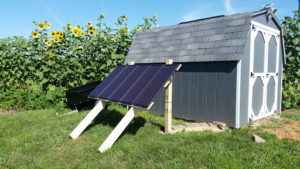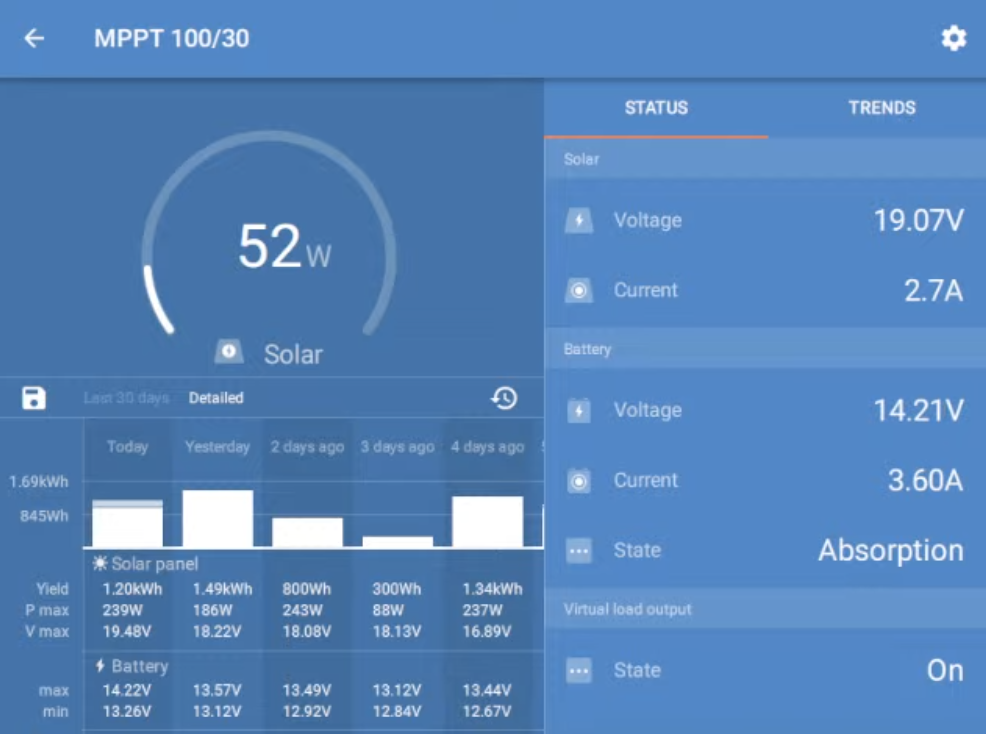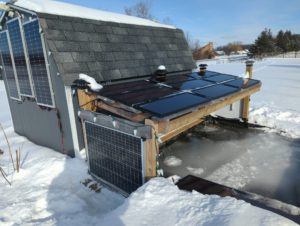The solar shed started with a 25W Thunderbolt solar panel from Harbor Freight. It was hooked to a Lawn & Garden battery (bad idea!) and that did not last long.

The first upgrade was to a 100 Watt Amorphous Solar Panel Kit from Harbor Freight. This setup produced 125W (theoretically) to a group of lead acid batteries.
The first batteries were Duracell marine / RV deep cell batteries. These deep cell batteries were fine and had about 75Ah per battery. When connected in parallel, two of those batteries could store 150Ah which amounts to 1,800Wh. Running 35W appliances (e.g., pond pump) for 24 hours, that is enough energy to last about 2 days. That is a great starter solar array but is not sustainable for the long term.
Batteries
The solar shed contains two batteries which are the following brand and capacity: CHINS 12V 200Ah Lithium (LiFePO4) Battery; 4000+ Cycles; 2560W Load Power. Here is what those numbers mean:
- 12V means 12 volts. This measurement is important when charging the battery.
- 200Ah means 200 amp hours. This is how much energy the battery can store.
- 4000+ Cycles means it can recharge 4000 times (e.g., daily) and lasts about 10 years.
- 2560W Load Power tells you how much energy you can use. For example, if you have a laptop that uses 250W then you could use that laptop for about 10 hours on a fully charged battery.
Ironically, 12V batteries charge higher than 12V and do not use up volts all the way down to zero. The actual usage range is somewhere between 12V (low) and 13.3V (high) charge. See the charging chart located below.
Charging
Fully charged batteries, in our setup, would be 13.3V when there is no solar charging and no devices using the batteries. This can be measured at night when there is no sun. We see this measure in two ways: (i) View our live stream solar battery monitor at night and (ii) Look at the “min” battery charge each day on our battery monitor. That measurement should fall somewhere in the green range on the chart below.



Sample with 5,000 kWh
13.6 = 5,000 kWh
13.3 = 4,500 kWh
13.2 = 3,500 kWh
13.1 = 2,000 kWh
13.0 = 1,500 kWh
12.9 = 1,000 kWh
Loss of 5,000 kWh
13.6 = 0 kWh
13.3 = 500 kWh
13.2 = 1,500 kWh
13.1 = 3,000 kWh
13.0 = 3,500 kWh
12.9 = 4,000 kWh
-% at 5,000 kWh
13.6 = 100% kWh
13.3 = -10% kWh
13.2 = -30% kWh
13.1 = -60% kWh
13.0 = -70% kWh
12.9 = -80% kWh
There are three stages the batteries charge. The normal stage is called bulk charging which means the batteries are not full and need to be charged.
The second stage is absorption which means the battery is constantly at a fully charged state, the system can disburse power, and the battery only takes as much solar energy as needed to maintain its fully charged state. The battery is actually higher (14.21V) than fully charged for this state.
The final stage is float which is a lot like absorption but the battery reduces its constant voltage (13.49V) to prevent overcharging.
Monitoring
The solar shed has a Victron Energy SmartSolar MPPT 100V 30 amp 12/24-Volt Solar Charge Controller (Bluetooth) to help monitor the solar input. That device has a long name but there are only a few important words:
- Victron Energy is a reputable company in the Netherlands
- MPPT stands for “Maximum Power Point Tracking”
- The unit handles 12V or 24V systems (the solar shed is 12V)
- It has an app that can be used with Bluetooth or USB
- There are add-ons that can be purchased for more features
The charge controller in the solar shed has two add-ons:
- Victron Energy VE.Direct to USB Interface
- Victron Energy Smart Battery Sense, Voltage and Temperature Sensor, Long Range (up to 10m)
The charge controller is connected to a Mini-PC in the solar shed using a Direct to USB Interface. The Mini-PC broadcasts to YouTube using OBS Studio software and a Verizon Orbic hotspot. The solar charge and battery levels are viewable on the Holt Community Foundation live YouTube stream.
Michigan Seasons
There are many variables that contribute to the output of a solar system and one major consideration is location. The solar shed is in Michigan (USA) where the summers and winters are drastically different.
Summers in Michigan
The charge controller shows the current watts received in real time and logs the kWh of solar energy each day.

The image on the right shows the variability in sunlight on summer days in Michigan. This screenshot was taken at 7:20 pm on May 15, 2023. The solar output on this day (1.71kWh) was about 6x that of three days prior (300Wh).
This information is helpful because it can be compared against the usage per day. For example, all the equipment plugged in to the inverter usually pulls 35W. Since there are 24 hours in a day, that is 840 Watt-Hours of energy used per day.
Any time the solar shed produces more than 840 Wh per day, the batteries will charge and store the surplus energy. Any day the solar shed produces less than 840 Wh per day, the system will use the reserve energy stored in the batteries. The batteries have about 5,120 Wh of reserve energy when fully charged so they have roughly 6 days of reserve energy to use if there was a 6-day period with zero sunlight charge.
Winters in Michigan
Even on a sunny day in winter, the solar charge is minimal. There are four things to consider during the winter months:

- Angle (degrees) of the solar panels
- Duration of the daylight hours
- Snow covering the solar panels
- Amount of watts being used
The solar shed receives about 50% of the solar input on a good day during the winter. This means the solar system receives about 400Wh per day on a good day in December.
It is necessary to limit the amount of energy used by the system during the winter. While 800Wh is used per day in the summer, the solar shed reduces the amount of energy used to about 200Wh per day in the winter. This is done by restricting the devices to just the pond bubbler in the winter.